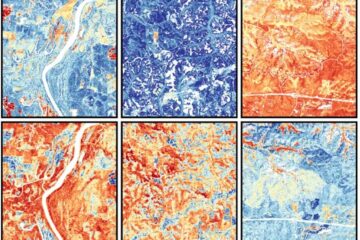Lasing mechanism found in water droplets

Water droplet contact angle dramatically increases lasing emissions, from Qiao et al., doi 10.1117/1.AP.3.1.016003.
Credit: Qiao et al.
Lasing mechanism at the surface of water droplets can be used to record mechanical changes at biointerfaces.
Tiny molecular forces at the surface of water droplets can play a big role in laser output emissions. As the most fundamental matrix of life, water drives numerous essential biological activities, through interactions with biomolecules and organisms. Studying the mechanical effects of water-involved interactions contributes to the understanding of biochemical processes.
According to Yu-Cheng Chen, professor of electronic engineering at Nanyang Technological University (NTU), “As water interacts with a surface, the hydrophobicity at the bio-interface mainly determines the mechanical equilibrium of the water. Molecular hydrophobicity at the interface can serve as the basis for monitoring subtle biomolecular interactions and dynamics.”
Water droplets have been used to form biological microlasers that exploit water’s intrinsic ability to confine light with minimal scattering. Droplet lasers benefit from laser oscillation in a microcavity, so any subtle changes induced by the gain medium or cavity can be amplified, leading to dramatic changes of laser emission characteristics. While droplet lasers have become cutting-edge platforms in biochemical/physical studies and biomedical applications, the optical interaction between droplet resonators and an interface has remained unknown.
As reported in Advanced Photonics, Chen’s NTU team recently discovered that when a water droplet interacts with a surface to form a contact angle, the interfacial molecular forces determine the geometry of a droplet resonator. Dramatic mechanical changes at the interface play a significant role in the optical oscillation of droplet resonators.
Chen’s group discovered an oscillation mechanism of droplet resonators, in which the laser resonates along the droplet-air interface in the vertical plane. Chen notes that this vertically oriented “rainbow-like” or “arc-like” lasing mode reflects back and forth between the two ends of the droplet interface, forming a unique and extremely strong laser emission. Chen’s team noticed that, unlike the commonly seen whispering-gallery mode (WGM), this newly discovered lasing mechanism is much more sensitive to interfacial molecular forces. According to Chen, “The lasing emissions of this arc-like mode increase dramatically with the increment of interfacial hydrophobicity, as well as droplet contact angle.”
Seeking to explain this modulating phenomenon, Chen’s team also found that the quality- factor of new lasing modes increased significantly with an increasing droplet contact angle. And the number of oscillation paths of lasing modes in droplets increased dramatically. “Together, these two factors determine the enhancement of lasing emissions with the strength of interfacial molecular forces,” says Chen.
Based on their discovery, Chen’s team explored the possibility of employing droplet lasers to record mechanical changes at biointerfaces. As anticipated, they found that a tiny change of interfacial biomolecular forces, induced by a very low concentration of biomolecules, such as peptides or proteins, can be recorded by the lasing emissions of droplet lasers.
According to Chen, “This work demonstrates an important modulating mechanism in droplet resonators and shows the potential for exploiting optical resonators to amplify the changes of intermolecular forces.” Lasing mechanism insights open new prospects for using microlasers to study biomechanical interactions and interface physics. As droplet lasers may provide a new platform for studying the intermolecular physical interactions at the interface, they could be particularly useful for examining hydrophobic interactions, which play a vital role in numerous physical dynamics and biological systems.
###
Read the original research article: Zhen Qiao et al., “Lasing action in microdroplets modulated by interfacial molecular forces,” Adv. Photon. 3(1), 016003 (2021), doi 10.1117/1.AP.3.1.016003
All latest news from the category: Physics and Astronomy
This area deals with the fundamental laws and building blocks of nature and how they interact, the properties and the behavior of matter, and research into space and time and their structures.
innovations-report provides in-depth reports and articles on subjects such as astrophysics, laser technologies, nuclear, quantum, particle and solid-state physics, nanotechnologies, planetary research and findings (Mars, Venus) and developments related to the Hubble Telescope.
Newest articles

Machine learning algorithm reveals long-theorized glass phase in crystal
Scientists have found evidence of an elusive, glassy phase of matter that emerges when a crystal’s perfect internal pattern is disrupted. X-ray technology and machine learning converge to shed light…

Mapping plant functional diversity from space
HKU ecologists revolutionize ecosystem monitoring with novel field-satellite integration. An international team of researchers, led by Professor Jin WU from the School of Biological Sciences at The University of Hong…

Inverters with constant full load capability
…enable an increase in the performance of electric drives. Overheating components significantly limit the performance of drivetrains in electric vehicles. Inverters in particular are subject to a high thermal load,…





















